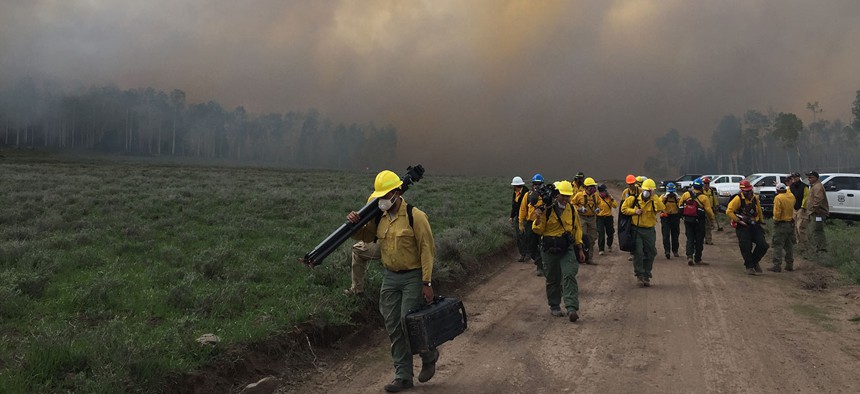Sometime later this month or in early November, if the weather cooperates, the U.S. Forest Service will fly a pair of fire-spitting helicopters over a remote mountain in southern Utah and set the forest ablaze.
While the helicopters are pelting burning liquid fuel at the treetops, dozens of firefighters will be providing support on the ground, using drip torches and flamethrowers to create a towering wall of flame that will stretch from the forest floor to the sky. As the heat builds and the blaze roars across spruce- and fir-stippled canopies, a small army of scientists will launch weather balloons and drones, drive radar- and LIDAR-equipped trucks around the perimeter, fly specialized research planes overhead, and gather data on fire-hardened GoPro cameras to analyze the inferno from start to finish.
It will be among the fiercest controlled burns scientists have ever studied in the wild—“as close to a wildfire as you can expect,” says Roger Ottmar, the principal investigator for the Forest Service–led Fire and Smoke Model Evaluation Experiment (FASMEE ). The goal? To collect data on every aspect of the fire at once, in order to improve the models scientists and land managers use to predict the impacts of fires. That will allow the agency to oversee more controlled burns on landscapes that need fire to thrive, and the data will also provide insight into the large, intense blazes that keep erupting across the West—the types of unruly fires that climate change and changing land-use patterns are making more common.
“The more experiments we can do, the better we can understand fire behavior in a changing climate,” says Craig Clements , the director of the Fire Weather Research Laboratory at San Jose State University and the science lead for FASMEE’s plume-dynamics and meteorology team. “This is the opportunity of a lifetime.”
The opportunity exists only because of the very specific ecological challenges facing Fishlake National Forest’s Monroe Mountain. The upcoming burn is part of a larger restoration project the Forest Service launched back in 2015 to revive the area’s ailing aspens, explains Linda Chappell, the regional fuels program manager. These trees, which provide food and shelter for a wide array of animals, including elk, rabbits, porcupines, beavers, and countless birds, have been declining across the West for decades due in part to overgrazing by deer and livestock. Drought and disease have hit hard, too. And aspens, a clonal species , need wildfires to cue their roots to put out new “suckers,” or sprouts. Around Monroe Mountain, the frequency of wildfires has dropped dramatically over the past century, allowing a mix of conifer species to slowly take over.
One of the most effective ways to bring aspens back is to ignite a “crown fire”: a really big, really hot fire that jumps from treetop to treetop and sends flames writhing upward into the sky. The work is being done piecemeal over the course of a decade in order to introduce as much variation as possible into the mountain ecosystem. “We want a crazy quilt of aspen ages and a crazy quilt of conifer ages,” Chappell says. Because these prescribed crown fires are so similar to wildfires in terms of their intensity, the restoration project served as the ideal natural laboratory for FASMEE to piggyback onto.
The FASMEE team has already pulled off one pyrotechnic science bonanza this year. In June, the Forest Service ignited a crown fire at a site near the south end of Monroe Mountain called Manning Creek , torching about 1,100 acres. Scientists watched from a safe distance as the sky grew dark and dim—a surreal wash of brown and orange that might have been sunset on an alien world. A roaring whoosh filled their ears as smoke churned and billowed overhead. Eventually, the air itself was a roiling mass of flame. “It was an awesome fire,” Clements says.
In June, scientists collected a trove of data on a controlled burn in southern Utah. (USDA Forest Service / Jessie Manning)
The Forest Service’s plan, this time around, is to ignite about 750 acres of forest on the northern side of Monroe Mountain and let the flames finger their way upslope over another 800 to 1,000 acres. As in June, rangers will light the fire primarily from the air using “helitorches ,” flame-throwing helicopters that would fit in perfectly on the set of a Mad Max movie.
Before the burn, teams will cut fire lines through some of the dense parts of the forest to keep the blaze from spreading beyond its planned perimeter, Chappell says. The Forest Service will also be counting on the weather to keep the fire in line. The agency is intentionally setting the burn toward the end of fire season, when the weather is cooler, both to keep it from growing so intense as to obliterate everything in its path—the goal is a fire that consumes about 60 percent of the trees and other kindling it encounters—and in the hopes that it’s followed by rain or snow.
“They’re hoping nature will put it out,” Ottmar says, although they’ll also have fire engines, pumps, and hoses on hand to stop any unruly flames, and the helicopters can be reequipped with buckets of water.
While the fire is burning, some 50 to 80 scientists will deploy an immense arsenal of instruments: a brand-new Doppler radar system capable of scanning the entire volume of the smoke plume in high-resolution; fire-hardened cameras and heat sensors; drones that measure smoke chemistry and film the burn from the air; weather balloons that profile conditions throughout the atmosphere. A fixed-wing aircraft will fly back and forth over the blaze while its onboard Fire Mapper-2 instrument measures heat output, data that’s crucial for “capturing the evolution of fire,” says Nancy French, a fire researcher at Michigan Technological University who’s heading up FASMEE’s fire-behavior and energy team. The Forest Service research meteorologist Brian Potter, meanwhile, is planning to deploy small sensors capable of detecting “infrasound,” sounds emitted below the range of human hearing by volcanoes , thunderstorms , and, perhaps, wildfires. To date, Potter says, researchers have looked at a number of smaller prescribed fires and heard nothing, but there’s always the chance they’ll pick up some murmurs on this burn.
All this technology is intended to cover four main study areas : fuels and consumption, fire behavior and energy, plume dynamics and meteorology, and smoke and emissions. After the burn, some follow-up studies will look at soil heating and aspen regeneration, Ottmar says. The troves of data being collected will be studied for months if not years, helping scientists paint a detailed picture of the inferno as it leaped across the landscape, scouring treetops and demolishing soil. Long after the last embers have cooled and suckers are sprouting anew from the wreckage, humans will be tracing the fate of tiny bits of bygone soot kicked aloft during the blaze, and using their findings to prepare for a fiery future.
The scientists are lucky to be doing this experiment at all. The original FASMEE plan called for $8 million to fund three campaigns. Most of the funds were to be provided through the Joint Fire Science Program (JFSP), a collaboration between the Forest Service and the Interior Department. But in 2018, for reasons that aren’t entirely clear, the JFSP’s budget was slashed from $9 million to $3 million, restricting the program’s ability to contribute to FASMEE. The Forest Service had already completed its study plan, though, and the scientists wanted to see the project through. So the JFSP, along with the Forest Service itself, scraped together enough money to save at least two of FASMEE’s planned campaigns: an effort to characterize the impacts of wildfires that burned out West this summer, and the experimental burns in Utah. But they did so at a cost. All told, FASMEE has received only $2 million to date. And the cuts have limited the scientists’ ability to collect certain types of data and begin data analysis, Ottmar says.
Ottmar remains optimistic, emphasizing that FASMEE is alive today because the scientists involved saw an “exceptional opportunity” and came together to make it happen. Other researchers, however, are openly frustrated at the uncertain funding environment and the steady attrition of federal dollars for fire-science research over the past decade even as fire season grows longer and worse.
“To have this kind of test of operational fire models will be really important for understanding how to simulate fire growth, smoke-plume development, and trajectories,” says Jessica McCarty, a geographer and fire scientist at Miami University who isn’t directly involved with FASMEE. “That really helps us with being able to alert the actual communities that are at risk.”
While the future of federal fire-science research remains in limbo—this year, early budget drafts from the Forest Service and Interior Department proposed eliminating the JFSP entirely, but Congress boosted the program’s budget back to $6 million—scientists are looking forward to collecting a wealth of data on the upcoming burn. But one force even more capricious than Washington politics could still throw a wrench in things: the weather. If the snow falls early this year atop Utah’s highest peaks, the Forest Service may have to put everything on hold until the spring.
So far, though, later this month is looking like a promising time for an epic burn.
“I am pretty hopeful,” French says. “These people know what they’re doing.”













